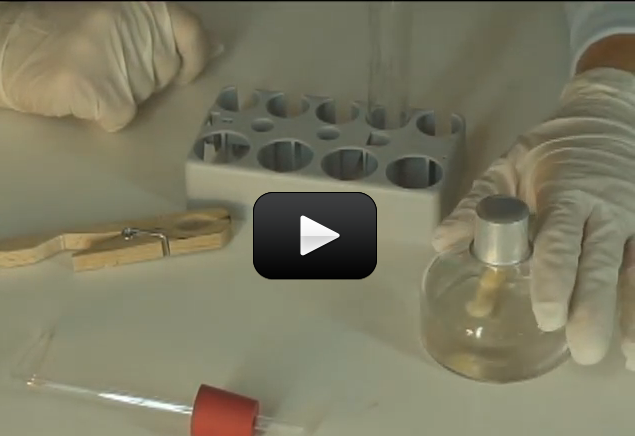 If you’ve ever owned a fish tank, you know that you need a filter with a pump. Other than cleaning out the fish poop, why else do you need a filter? (Hint: think about a glass of water next to your bed. Does it taste different the next day?)
If you’ve ever owned a fish tank, you know that you need a filter with a pump. Other than cleaning out the fish poop, why else do you need a filter? (Hint: think about a glass of water next to your bed. Does it taste different the next day?)
There are tiny air bubbles trapped inside the water, and you can see this when you boil a pot of water on the stove. The experimental setup shown in the video illustrates how a completely sealed tube of water can be heated… and then bubbles come out one end BEFORE the water reaches a boiling point. The tiny bubbles smoosh together to form a larger bubble, showing you that air is dissolved in the water.
Materials:
- test tube clamp
- test tube
- lighter (with adult help)
- alcohol burner or votive candle
- right-angle glass tube inserted into a single-hole stopper
- regular tap water


Hi Aurora,
What do you mean by “air” since we learned that “air” is mostly nitrogen- 70%+ and some oxygen, etc. In this experiment, if you were to say that the released bubbles are air molecules, do you mean there is some nitrogen molecule in the bubbles? Or since the tube started off with water, H2O, we are to assume that the bubbles are made up of hydrogen and oxygen molecule?
Home Science Tools is an excellent resource for most Chemistry supplies (and many other topics as well!)
You can easily make a bend in a 5mm glass tube by heating the tube in a candle or alcohol burner flame until the glass softens. Then carefully bend the tube to the desired shape and hold it in that position for a few seconds until the glass hardens again. Be sure to heat the glass tube over a section about 1‐1/2′ long to avoid crimping the tube when you bend it.
I hope this helps!
Hi. Where can I buy a test tube clamp and right-angle glass tube inserted into a single-hole stopper?
cooooooollllllllllllllllllll!!!!!!!!!!!!!!!!!!!!!!!!!!!!!!!!!!!!!!!!!!!
It depends – fish tanks can be heated with a heater you stick in the water, or by a strong special kind of light, or not at all, depending on the type of fish. This experiment is showing you how there’s oxygen in the water that the fish can extract to live. Without it, they will die.
Mrs. Lipper, how do the fish survive? Their water is not heated! Is that why people have a light in fish tanks?
Did you notice the position of the test tube in the video? Why do you think it’s needed? 🙂
Why did you need the bended tube ?
That’s cool! I had a fish when i was 7 and I forgot to change his water… Sorry Fred. DX
Cool!!!!!!!!!!!!!!
I guess fish can drown
Oops! Sorry about that… and thanks for letting us know. I’ve uploaded the right one for you now. 🙂
The video for “Can Fish Drown” is the two acid/base videos instead. Can you direct me to the actual “Can Fish Drown” video? Thanks
Well now I know why my fish died, I guess i didn’t change out the water enough….R.I.P 🙁
Yes, glass breaks if it heated unevenly. For example, if you heat one side of a glass container, it expands and since glass is not very flexible (it’s brittle), it will cause the glass to break because the cold side didn’t expand with the heated side.
Is there anyway possible to get the glass can break from the heat
I just had a light bulb moment! thank you for having so much patience with me.
I think I am responding to two different questions at once… that’s where the confusion is coming from.
Yes, electrolysis separates O2 and H2.
When you heat water on the stove, the bubbles are trapped air coming out of the solution.
Does that help?
I am sorry, I am just having a hard time understanding this. Electrolysis separates the Hydrogen from the Oxygen. Since we are not adding electricity to the water and only heating it up, what are the bubbles made of? oxygen? hydrogen gas? or just actual air trapped in the water?
Maybe I am not understanding your question. The Hydrogen gets bubbled into the test tube, forcing the water out so you are left with a tube full of H2.
I am looking forward to doing the electrolysis experiment. I am still curious where the hydrogen went inside the close test tube. did it just get mixed in with the water?
Actually that’s an excellent question (both of them). Yes you could do this in a couple of different places, like Unit 3, 8, 15, 16-19… but I decided to go with the hydrogen and oxygen atoms and stick it with matter and chemistry. You can split the H and O atoms apart in this experiment on electrolysis and capture them in separate test tubes. And if you like fuel cells, you can build your own that uses energy to split apart the water molecule, store the H2 and O2 separately, and then recombine the H2 and O2 to get power to turn the wheels in the fuel cell car experiment.
I have to questions: why are we doing this in chemistry? is it because you are connecting that water actually has oxygen in it? Hence H2O. This is probably a dumb question, but when we separate the oxygen from the hydrogen, where does the hydrogen go?
Yep… thanks for your eagle eye!
Edit:
Second paragraph “There’s tiny air bubbles…” Shouldn’t this be “There are tiny air bubles…”, bubbles being plural?
I am so sorry you’re having trouble! I’ll have my team contact you right away.
I am very frustrated! I’m trying to teach my eighth grader chemistry and everything I click on tells me that I don’t have access to it. Also all of the eighth graders in our area are studying the periodic table this year and yet we are unable to access that information without upgrading to the 9-12 program. So far we have been more irritated than enlightened by this curriculum. HELP!
You can find denatured alcohol at the hardware store (it’s used as a solvent). They usually don’t ship large quantities of it because it’s a hazardous material.
ok thanks. one more thing. Denatured alcohol is what I put in the burner right? They only gave me a little bit in the 3000 set. Can i use rubbing alcohol instead or where can I get more? Thank
Are you sure it’s from us? We don’t send powders out, especially ones that are not marked or labels correctly. We do send out gears, propellers, etc that sort of thing. If you can send a picture to us at [email protected] we can try to help you out.
could you help me figure out what i have here? it’s something you sent me in mail in a small bag 2 inches by 2 inches. it’s gray and heavy and is the consistancy of sand but heavier and dark gray in colour. is it zink powder?thanks
I was thinking, “If oxygen dissolves more easily into cold water, making it easier for fish to breath, do fish that live in cold climates live longer?” Do you think this is true? Thanks!
Kaelen.
As the water heats, oxygen is released from the water. That air bubble that forms in the test tube displaces water as the bubble grows. The water must go somewhere when displaced by the oxygen, and that is what you observed as the water level rose in the glass tube.
i noticed that the water in the glass tube went up when it was heating, why? was it because of the air was pushing it?
The soot on the outside of the glass from the burner can be wiped off with a damp cloth. Make sure that when you do this that your test tube has completely cooled.
uh… Aurora I think you need to change the tube because the tube was burning…
Pretty Cool. Maybe thats why my fish, R.I.P., died a couple years ago.